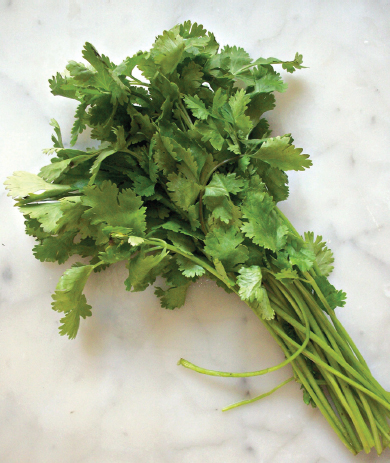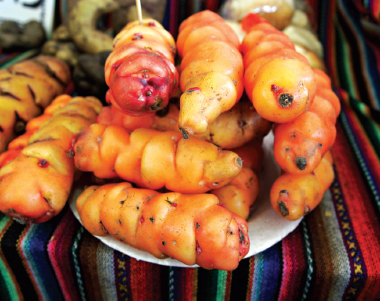
TUBERS
Mashua
Similar in looks, but not as popular as potatoes, mashua is considered the antidote for an overindulgent sex drive (yes, there is an antidote for that!). It can be eaten on its own, or as part of many dishes, by roasting it, mashing it, or adding it to many sweets and desserts. An easy way of enjoying its sweet side is roasting it and serving it with honey. Its neutral flavor also makes it the ideal side dish. When they want to use this tuber, Andeans put it in the sun for a day or two to bring out all its best qualities.
Oca
This tuber is sweet, especially if kept in the sun for a couple days before cooking, just like mashua. Its starch content is low, giving it a less floury texture than potatoes, and it is so versatile that it can be used in sweet or savory dishes alike. You can make a gratin with layers of oca and other tubers, or mash it instead of potatoes whenever you want a comforting meal.

Olluco
This Andean tuber looks like a small, finger-shaped potato, with colors that range from pale to bright yellow, to orange, pink, and red. It has a somewhat slimy and watery texture, very different from the starchy and doughy characteristics of a potato, and it can be eaten raw or cooked, and always unpeeled (just scrub it under running water and cut it in fine sticks or round slices). The preferred way of cooking it is in stews and chupes (thick soups). Of these stews, ollucos with charqui—dried llama meat—is far and away the most popular. The name of this ingredient comes from the Quechua word ullucu, which means “tuber.” It is also called papalisa (smooth potato).
Sweet Potato
Delicious and nourishing, the sugar content of this tuber makes it extremely sweet and energizing. Sweet potatoes also help regulate high blood pressure, and are fantastic to relieve stress. One inch of sweet potato added to juices will give you bright and shiny hair. You can find white, purple, and orange varieties, but Peruvians love the sweeter orange ones to serve next to a fresh cebiche, or thinly sliced, fried, and stacked inside a pan con chicharrón (pork sandwich).
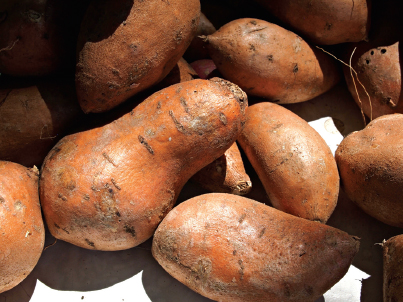
Maca
Maca is a root, sometimes considered a tuber, and it belongs to the carrot family. It is known as the “Peruvian ginseng” for its energizing properties. Maca increases the body’s resistance to stress, trauma, and fatigue, and boosts sexual function (this is the reason why it’s also known as the Inca’s Viagra). It is also popular to relieve depression and anxiety, and brighten your general mood. Use it sparingly in juices and smoothies because its strong flavor can be overpowering (one teaspoon a day is a good dose to start). If you happen to find fresh maca, make sure you cook it before using it. To do this, you first need to peel it, and finely chop it or grate it, and then cook it in boiling water until soft (about 30 minutes).
POTATOES
Potato
This is one of the stars of Peru’s rich soils, as our country boasts over three thousand types of potatoes. Carb haters may have given it a bad reputation in the past few years, but Peruvians have been thriving on this tuber since ancient times. Potatoes are a great source of vitamins and minerals, and they are also rich in iron, antioxidants, fiber, potassium, and magnesium. One tablespoon of raw potato juice before breakfast is a great way to calm gastritis and rheumatism, and folk medicine claims that the water in which potatoes have cooked is good to relieve kidney pain and to prevent kidney stones.
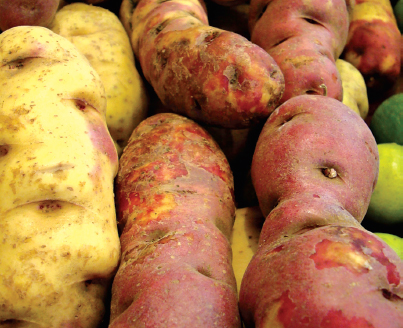
Papa Seca
Drying potatoes is an ancient technique that is still in use to preserve these crops. Incas were so efficient at growing potatoes that they dried and stored the surplus, eradicating famines from their culture, as papa seca was always in stock. The drying method consists of cooking potatoes in boiling water, peeling them, and cutting them in medium-sized cubes or thin sticks. Then these pieces are sun-dried until they lose all their moisture and look like small crystals. After this process they are ready to be stored for a long time (more than a year).
When buying papa seca choose the ones with a yellowish color, believed to be of better quality than the transparent or brown ones. You can buy them in bulk at any Peruvian market, or in grocery stores where they are sold already packed. Store them at room temperature.
Papa seca is the main ingredient of a famous dish called Carapulcra, but sometimes a mix of fresh and dried potatoes is used to make it. This sturdy entrée is made with pork and chocolate, and is accompanied by a side dish called Sopa Seca, which means “dry soup,” made with noodles.
Chuño
This name comes from the Quechua ch´uñu, which literally means “freeze-dried potato.” Chuño is made with regular potatoes that are dried in the heights of the Andes. The word also refers to a very fine potato starch made with the same freeze-dried potatoes, which are commonly used to thicken sauces and desserts such as Mazamorra Morada.
There is white and black chuño. The latter is made with bitter potatoes, which are left to freeze overnight in the open air. In the morning, they thaw under the sun, and then they are crushed to extract their liquid, and frozen all over again at night. This process is repeated many times until the potato is completely dehydrated.
To make white chuño, on the other hand, potatoes are soaked in the icy cold water of rivers and streams for several days, and then sun-dried.
Chuño has an extremely long shelf life (it lasts for several years), and it has been part of the Andean diet for centuries. To consume it, you need to rehydrate it by soaking it in water. It is mainly used to make Andean soups and stews, or you can just cook it and eat it with corn and cheese.
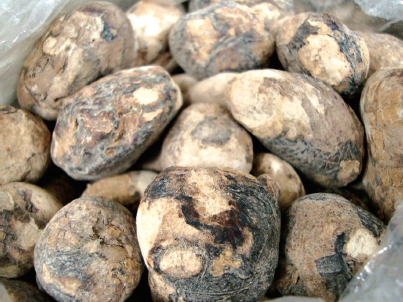
CORN
Choclo
We call it choclo, and it has been one of the main staples of Peru’s daily diet for thousands of years. There are dozens of varieties in every color and size imaginable, but the most used has giant, meaty kernels (about the size of a thumb fingernail or bigger) that are full of crunch. With choclo we make tamales, cakes, breads, and soups, or we eat them boiled or roasted, accompanied by big chunks of salty queso fresco and ají sauce. When boiling corn, we add a couple tablespoons of sugar to the water and an aniseed teabag. A few drops of lime juice is optional if you want to keep the kernels pearly white.
Mote
Giant kernel corn is boiled with wood ashes or slaked lime to peel the kernels. This process is known as nixtamalization in Mexico. Then the kernels are peeled and dried and used in several Andean savory dishes, and in some desserts like champuz. It’s very similar to hominy (you can replace it with it), and it can also be eaten cooked and accompanied with some artisan cheese.
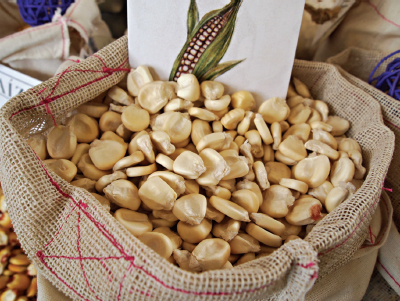
Purple Corn
This is one of the many varieties of corn native to Peru. It has gained status as a superfood thanks to its diuretic effect and its incredible antioxidant content, which gives it its intense purple color. Sold dried and by the kilo, purple corn is the main ingredient of the refreshing drink called chicha morada, and of the traditional dessert with Arab roots known as Mazamorra Morada.
To use purple corn you usually make purple water, and then use that water in your cooking. To do this, take the kernels off the cob first, but don’t you dare discard the cobs because that is where the secret lies: the cobs render even more color than the kernels! Add both cobs and kernels to a large pan with apples, quince, pineapple peels, cinnamon sticks, cloves, and allspice, cover with water and bring to a boil until the water has a deep purple color (about 45 minutes). Cool and strain, discarding the solids. With this water you can make a unique purple rice that will have a beautiful color and also a fruity and spicy flavor.
Cancha
Different varieties of dried corn (chulpe is one of them) are used to make the Andean version of popcorn called cancha. Don’t expect anything like the popcorn you’re used to eating at the cinema (which, by the way, is called canchita in Peru). These corn kernels are toasted in a clay pot with or without oil, and as soon as they start to crack open, salt is added to them. The result is a crunchy, starchy, golden kernel that is served at the table to nibble on before a meal, and that is highly addictive!
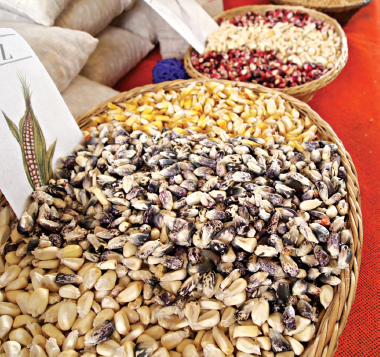
AJÍ
Ají Amarillo
Chili peppers are native to the Andes. Ancient Peruvians relied on salt, herbs, and ají as seasonings, and when the pre-Hispanic man wanted to offer a sacrifice to the gods, he fasted avoiding ají, salt, and sex for a few days. Ají amarillo has a crisp texture, paired with a floral aroma and a bright orange color (despite being called yellow chili pepper). As long as you remove the veins and seeds, it can be eaten cooked or raw. In fact, raw sliced or blended ají amarillo is the base for many of our traditional dishes. Strangely, this chili pepper has several names, and none of them is a true description of it: ají escabeche, ají amarillo (yellow chili pepper), and ají verde (green chili pepper).
Ají Limo
This chili pepper comes in a rainbow of colors: red, orange, yellow, green, white, and purple. It is used both to add a colorful note to many dishes, and to spice them up as well. Ají limo is a medium-sized pepper (about 2 or 3 inches long), and it is one of the oldest and hottest found in Peru. Some people say that it stores most of its heat in the tip, but beware of the seeds and ribs too! Ají limo is usually eaten raw, and is a must in cebiches and tiraditos. Nowadays you can find ají limo paste in Latin American grocery stores all around the world.
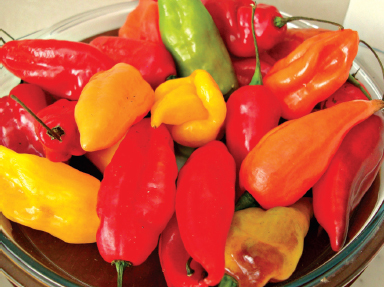
Ají Mirasol
This is a sun-dried chili pepper with a unique earthy flavor and intensity. It is less floral and citric than fresh ají amarillo, but has a more complex and concentrated taste that goes well with soups and stews. Seed and devein it first, toast it in a dry pan over medium heat until fragrant, and then blanch it in boiling water, changing the water three times to reduce its heat. Some brave people like to deep-fry the whole pepper until golden brown, and serve it over bean stews or chupes (Andean soups).
Ají Panca
Another basic ingredient in countless Peruvian recipes, this sun-dried chili pepper has a brick red color, and a smoked aroma and flavor that brings depth to many slow-cooked dishes. It is also sold as ají especial (special chili pepper), or ají colorado (red chili pepper).
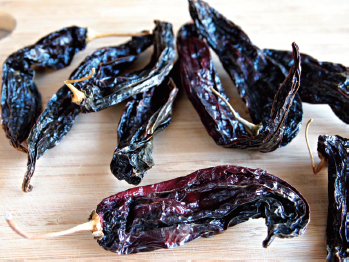
Rocoto
This is one of the hottest chili peppers from Peru, despite its innocent appearance, which is very similar to a bell pepper. Rocoto is mainly used raw as a condiment, adding just a small amount to some dishes to give them a fiery kick.
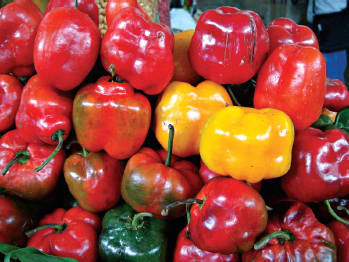
SEEDS
Kiwicha (Amaranth)
With tiny seeds smaller than quinoa, this is an ancient and nutritious American crop, known and consumed in Mexico and Peru. It was banned by the Conquistadors—just like quinoa—because they attributed magical powers to it, claiming it was used for witchcraft. Nowadays, it is found as amaranth in many international stores. You can use it in similar ways as quinoa, but keep in mind that kiwicha is smaller, takes a bit longer to cook, and has a slightly sticky texture that is terrific for making healthy puddings.
Quinoa
Chances are you are familiar with quinoa by now (pronounced keen-wah), or have heard of its nutrient-dense properties. “A complete protein” is what we´ve heard the most when it comes to this powerhouse, and indeed it is a complete protein, as it contains all the essential amino acids, on top of iron, calcium, vitamins E and B. What very few people know is that despite being treated as a cereal, this wonderful ingredient is not a grain, but technically a seed. We learned this from a friend whose glucose was alarmingly high and was prohibited to consume any sugars or grains by her Chinese medicine homeopath. She broke the wonderful news: quinoa was not on the forbidden list.
This superfood has been a staple of the Andean diet throughout the centuries, and it grows high in the mountains despite the cold weather. The Incas considered it sacred because it provided them with energy and good health, and they loved to offer it to their gods.
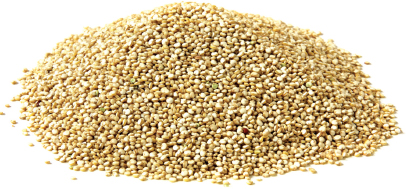
VEGETABLES
Caigua
This Quechua name means “cucumber,” and the seeds of this fruit have been found in ancient tombs dating back to 3700 BC. Caiguas are like green capsules filled with black seeds and a hairy vein. They can be eaten raw (in salads), or stuffed with meat, fish, chicken, or vegetables and served with rice on the side. Legend has it that the bitter juice of this vegetable aids in losing weight and lowering high cholesterol levels. Adding the juice of half a lemon will make it palatable and easier to drink.
Loche Squash
This beautiful squash also goes by the names of lacayote, avinca, and simply zapallo (squash). It comes from the northern coast of Peru and has been widely used in the gastronomy of this part of the country since pre-Columbian times. The flowers and the fruit are used both in savory and sweet dishes. Loches are very pretty too, sometimes resembling swans or ducks. This squash is indispensable when making northern dishes like rice with duck.
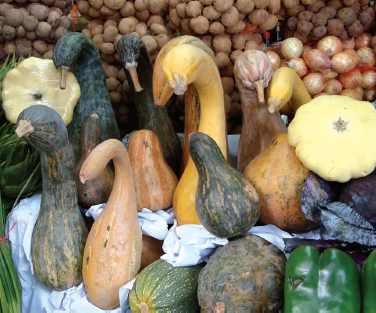
Macre Squash
This squash is the most popular in Peruvian cooking. It is one of the largest in the world, with more than one hundred pounds of golden-orange pulp. We use it for locros, soups, purees, and even to make risotto or fill many types of pasta. It makes a delicious sweet as well, cooked in molasses syrup.
FRUITS
Aguaymantos (Golden berries).
They look like tiny yellow tomatillos covered with papery husks, but have a juicy pulp full of miniature seeds. These berries are a lovely addition to salads, yogurt, juices, shakes, and desserts. Their delicate sweet and sour flavor is also fantastic when cooked in sweet or savory sauces. If you’re a vegetarian, you will be happy to learn that this fruit is considered a superfood thanks to its high content of many nutrients, including vitamin B12, iron, and protein.
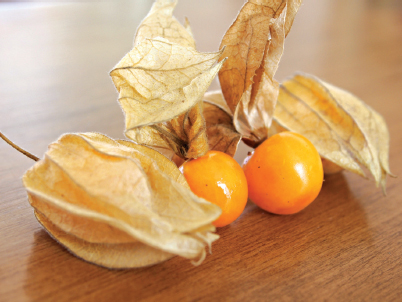
Camu Camu
This small round fruit grows wild in the Peruvian and Brazilian rain forests, and it resembles a large grape with green, red, and yellow colors fused together. Camu camu has big seeds and a juicy pulp, and it is considered the richest source of vitamin C in the world, and as such, a superfood. It is unlikely that you will find the fresh fruit in markets or grocery stores outside of Peru, but dried camu camu powder is sold as a nutritional supplement in many health food stores and in some regular grocery stores.
Cocona
This bright orange berry is the size of a large avocado, looks like a conic tomato when cut in half, and has a very acidic flavor. Originally from the Amazon jungle, it’s one of the favorite ingredients of the local cuisine, and widely consumed in the form of spicy sauces, juices, nectars, ice cream, popsicles, and desserts.
Consume cocona only when very ripe. You will know it is ready when the skin begins to wrinkle.
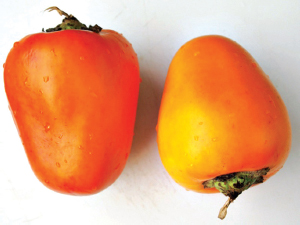
Granadillas
They belong to the passion fruit family but have a very delicate and sweet flavor, far from the acidity of passion fruits. The color of their juice is different as well—nearly transparent—nothing in common with the intense orange or yellow of their cousins. This juice is so sweet and mild, that in Peru it is the first fruit juice given to babies after breast milk (an ounce or so at mid-morning is energizing and they love it). To make it, place the pulp of some granadillas in a sieve and press with the back of a spoon to release the juice contained around each seed.
You can also eat granadillas just as they are. Their pulp is soothing for the stomach, the liver, and the nervous system. All you have to do is cut the hard peel in half with a knife or with your fingers, and eat it with a spoon.
Cherimoya
This name is a Quechua word meaning “cold seeds.” Cherimoya is so sweet and creamy that we highly recommend eating it on its own as a dessert, with no further embellishments. This fruit can be used in desserts, ice creams, cakes, juices, and smoothies. To eat, make sure it’s soft on the outside, and then proceed to peel the fruit and discard the black seeds, which are inedible.
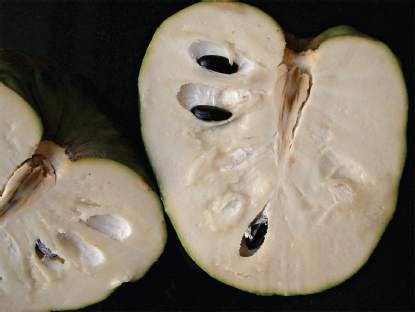
Limes
Asian in origin, this crop came to Peru via the Spanish colonizers, and adapted itself to the soil and climate of Northern Peru. Our variety—we call it limón sutil (subtle lemon)—is smaller than others and has an intense acidity, perfect to marinate the raw fish used to make cebiche. To get the best of its juice, it should be squeezed with a gentle hand, just enough to get the juice out without the bitter oil from the skin.
Lúcuma
There is nothing like fresh lúcuma to make desserts and shakes. Its pulp has a beautiful orange color, with a characteristic fragrance similar to the Mexican and Central American zapote; but its texture has nothing in common with this tropical fruit, being creamy and starchy instead of juicy. You will know a lúcuma is ripe when the skin starts to burst open. Discard the large seeds, and process the pulp to use in any recipe you want (desserts love it!).
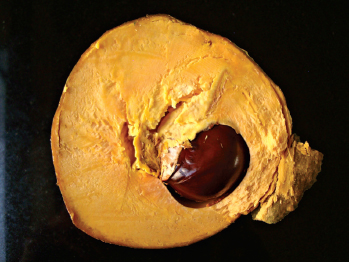
Maracuyá (Passion Fruit)
Like most Peruvians, we love the acidic flavor and floral fragrance of this fruit, and as a bonus, its flower is one of the most beautiful things we have ever seen in nature. This is not a taste to be enjoyed on its own, but it is ideal to flavor beverages, nectars, desserts, and sweet and savory sauces. The variety of passion fruit we find in Peruvian markets is yellow and heavy for its size, because the pulp is full of seeds and juice. Buy them when they are plump and the skin is starting to show wrinkles. To juice them, strain the seeds by putting the pulp in a sieve and pressing with a spoon to release the liquid. You can also process it in the blender with quick pulses or at low speed to avoid grounding the seeds, which should be discarded before using.
Sachatomate
Its name is Quechua and means “tree tomato,” but in other parts of the world it is known as tamarillo. It is very similar to a tomato both in flavor and texture, and there are a few varieties of it in Peru. We like to enjoy them in spicy sauces, desserts, and compotes. Sachatomates can be eaten raw or lightly cooked.
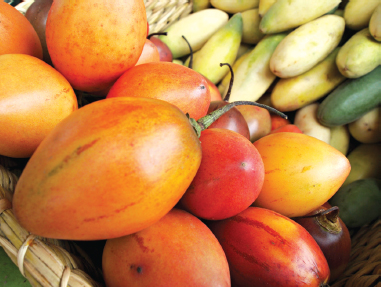
Tumbo
This fruit looks different from its relatives, passion fruit and granadilla. Tumbo has an oval shape, and ranges in size from about five inches long, to the giant variety of the Amazon that weighs more than five pounds. Its skin has the same yellowish color of passion fruit, but it is softer. Cut lengthwise or crosswise, you will find hundreds of black seeds, each surrounded by a bubble of orange, tart juice. This is used to make refreshments, desserts, and ices.
Tomatoes
Surprise, surprise! This fruit, consumed as a vegetable, is native to Peru, and didn’t spread to the rest of the world until just a few hundred years ago. As a matter of fact, when tomatoes were first brought to Europe, they were considered potentially dangerous, and for many years were used only as decoration. No one could imagine the rave tomatoes were going to cause in the world´s gastronomy once people warmed up to their versatile taste.
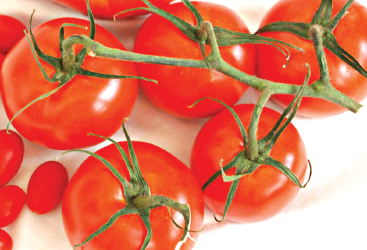
OTHERS
Sacha Inchi
This is an Amazonian legume very similar to a peanut. It can be eaten like a snack (we love it covered in chocolate), but the most common presentation nowadays is in the form of oil. This oil is a healing potion for the body, considered one of the world’s most powerful superfoods because of its high levels of antioxidants and essential fatty acids. One tablespoon a day in your salad dressing is enough to get all the healthy fats your body needs to stay in top shape.
Recently discovered by scientists, sacha inchi helps lower blood pressure, strengthens the immune system, has large amounts of vitamins A and E, lowers cholesterol levels, and is good for the digestive system, for the brain, and for the bones.
Be careful when adding it to salads, shakes, or other preparations, because it has a very strong flavor that some describe as fish like, and can take some getting used to.
Huacatay (Black Mint)
This is a popular herb used in many Peruvian dishes—mostly in the Andes—which imparts its characteristic pungent flavor to many soups and stews. It is hard to think of a delicious locro, or a creamy ocopa sauce without the sharp taste of this herb. You can also enhance a simple ají sauce with just a few chopped huacatay leaves or a teaspoon of huacatay paste.
This aromatic leaf is also called “black mint” because it is part of the same family of herbs. Just like mint, it’s better to use it sparingly, as it has a pungent taste that can easily become overpowering.
It’s not easy to find fresh huacatay outside of Peru, but you can easily buy it in paste form over the Internet and use this instead. Start with a little bit and increase the amount according to your taste.
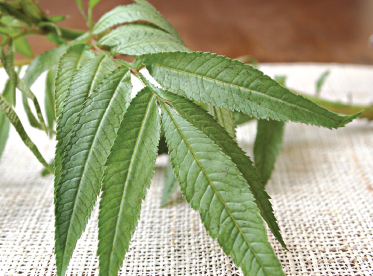
Sal de Maras (Peruvian Pink Salt)
In the valley leading to the lost city of the Incas, a unique salt harvest has taken place for 2,000 years. Like a vast marble staircase, about 4,200 terraces of salt tumble down the hillside toward the town. There are green, ochre, gray, white, and pink pools filled with this first-grade salt ready to be harvested. These healthy and nutritious pink crystals help stabilize and regulate heartbeat thanks to their sodium and magnesium content.
Cilantro
Also known as coriander, cilantro is one of the many herbs that came to Peru from other parts of the world. It contains many vitamins and minerals, promotes good digestion, and is a powerfully detoxifying herb. In Peru we only use the leaves, which are basic in soups like aguadito, in many rice dishes, in stews like seco, and to make a certain kind of tamales called tamalitos verdes (small green tamales). Store it in a plastic bag in the fridge, or keep it in a glass of water with the roots inside the water.
